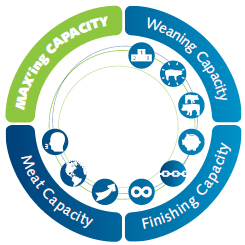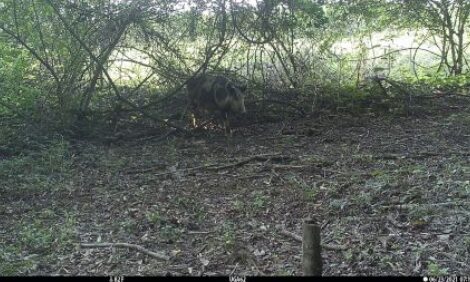



MAX'ing Weaning Capacity with Key Success Factor: Solid Sow Performance - 3
Solid Sow Performance is influenced by three main factors: Retention Rate, Sow Productive Lifetime and Stayability. In this article you will read Egidijus Mickevicius's expert vision on increasing profitability with focus on Retention Rate.
Increase total system profitability with MAX'ing Capacity
It is Hypor's philosophy that focuses on the bottom line result, linking the factors that influence the entire pork value chain.
MAX'ing Capacity is divided into three pillars that cover the chain: Weaning Capacity, Finishing Capacity and Meat Capacity. For every pillar, there are three key success factors with three articles each that concentrate on how to improve.
Retention Rate Influences Solid Sow Performance

Job title: Eastern Canada Sales and Service
Experience: 17 years
Drive: Reproduction and cost efficiency interaction
Life slogan: Knowledge is power.
Best customer experience: I am content and satisfied when my customers are satisfied.
Future: Different key performance indicators will be established as performance measurement guides. Greater efficiencies will be realised because of it. Knowledge of, and consistent plus timely monitoring of production costs will be key to success for our clients in order to compete.
Increasing total system profitability with MAX'ing Capacity is a combination of
various factors linking all to the pork value chain. With Weaning Capacity we look at
the beginning. Starting smart is knowing what to look for in a herd and get the most
out of it. The main factors that influence a herd's profitability are: genetics, handling,
environment, nutrition, health, acclimatization and adequate development of all
pigs. Having a good sow Retention Rate plays an important part in having a better
bottom line. The formula of it is easy enough, in practice, we see that the outcome
says a lot about how profitable a company is.
In this article, you can read more about how to maximise your Retention Rate and facts and figures of good examples.
The sow Retention Rate formula:
Sow Ret. Rate = Bred gilts entered into the herd (annually) ÷ Removals1 (lifetime)
1 Where Removals include voluntary culls (old age, sub-optimal reproductive performance, etc.), involuntary culls (structural issues, reproductive failure, etc.) and sow mortality (natural or euthanised).
Several articles have been written debating the threshold at which a sow reaches
financial break-even. Three parities, under reasonable market conditions, seems to be
the general consensus for recuperating the initial investment. Sow Retention Rate is
an excellent indicator of how well sows are lasting in a herd; Pinilla and Lecznieski
(2010) report a 69 per cent average retention rate up to parity three in a 40,000-sow
system while an inventory of over 180,000 sows in the US Midwest exhibited a
retention rate of 67.1 per cent up to parity four (Stalder, 2011).
The following chart reports retention rate trends for Hypor commercial herds in Eastern Canada over four years (Figure 1).

Source: Egidijus Mickevicius (2010). Unpublished.
A good herd parity structure is a sign that sows are able to remain in the herd to their most productive parities – parities three, four and five. Hypor incorporates Stayability to parity four in its breeding program to facilitate optimal parity structures in client herds. Caroll (1999) concluded that a stable parity profile distribution should be similar to that in Table 1 in order to maximize herd output and profitability. The ideal parity structure is also presented in the chart with roughly 80 per cent of sows remaining in production until parity four.

Adapted from Carroll (1999)
Herd parity structure strongly influences overall herd performance and the ability
to maintain consistent output from the herd. For example, the number of pigs
born alive per litter increases from parity one to three, peaks in parity three to six
and tends to decline thereafter. Stillbirth rates increase with parity, significantly
after parity five or six. Reproductive problems, such as anoestrus and returns to
service, are highest in young females, resulting in more non-productive days, while
farrowing rate is highest in parities two to six and then declines.
Overall, the most productive parities are three to six and therefore the aim should be to maximise
the number of sows in these parities. Because performance varies considerably
according to parity, a stable parity structure contributes to consistent output in terms
of the number of piglets weaned per week. Conversely, if parity structure varies
over a period of time, increased production variation often follows. In practice, this
happens more often than it should due to variation in the number of replacement
gilts entering the herd.
Proper management of retention rates is also known to have a positive influence
on a herd's reproductive performance. Pigs Weaned per Sow Lifetime is a good
indicator of reproductive performance and has a tendency to improve once the
herd parity structure is stable and involuntary culls are minimized (Figure 2).

Source: Egidijus Mickevicius (2012). Unpublished.
Analysing results and considering interference levels from a few real life cases and can be a good exercise. The two farms presented in Table 2 have better than average performance. Annual replacement rates are low in both cases and sow mortality is low as well. Both farms show a very high average parity at farrowing, which means they have sufficient high-parity sows for good Pigs Weaned per Sow Lifetime. In fact, there seems to be room to increase voluntary replacement a little. Higher replacement rates would lead to an improved herd parity profile and would likely lead to an improvement in Pigs Weaned per Sow per Year.

Some North American systems are running replacement rates around 55 per cent and
achieving below-average whole herd productivity levels. It is very important that
managers closely monitor and find a way to balance herd reproductive performance
versus replacement rate versus economic implications. Robust genetic products with high
genetic potential for Stayability will allow sufficient room for managers to optimise
replacement rates and performance.
Well-managed sow Retention Rate provides some of the following benefits:
- improved cull sow revenue and farm income
- reduced medication use/costs
- improved herd health stability
- reduced biosecurity risk
- improved return on genetic investment per pig produced
- improved animal welfare, and
- improved employee morale and well-being.
It is refreshing to see producers looking at their operations from different angles,
turning over every rock to find savings and challenging their suppliers to think
differently while working together. As we move forward, business decisions will
be based more and more on detailed analysis of impact of cost on production
performance.
This article is just one of many examples how a balanced genetic
programme can benefit your operation – allowing focus on optimising the operation
instead of solving basic issues. Good genetics is at the core of MAX'ing Capacity.
With Hypor's articles on Solid Sow Performance you can start smart today. Read
Stayability and Sow Productive Lifetime online at www.hypor.com/maxing.
References
1. Carroll C. 1999. Sow culling and parity profiles. Proceedings of the Pig Farmers’ Conferences Teagasc 1999, 35-41
2. Pinilla, J.C. and Lecznieski L. 2010. Sow removal and parity distribution management, 1-9
3. Stalder K. 2011. Reducing sow breakeven costs. Gene Link, 6:24-25

Further ReadingGo to the previous article in this series by clicking here. |
November 2012






